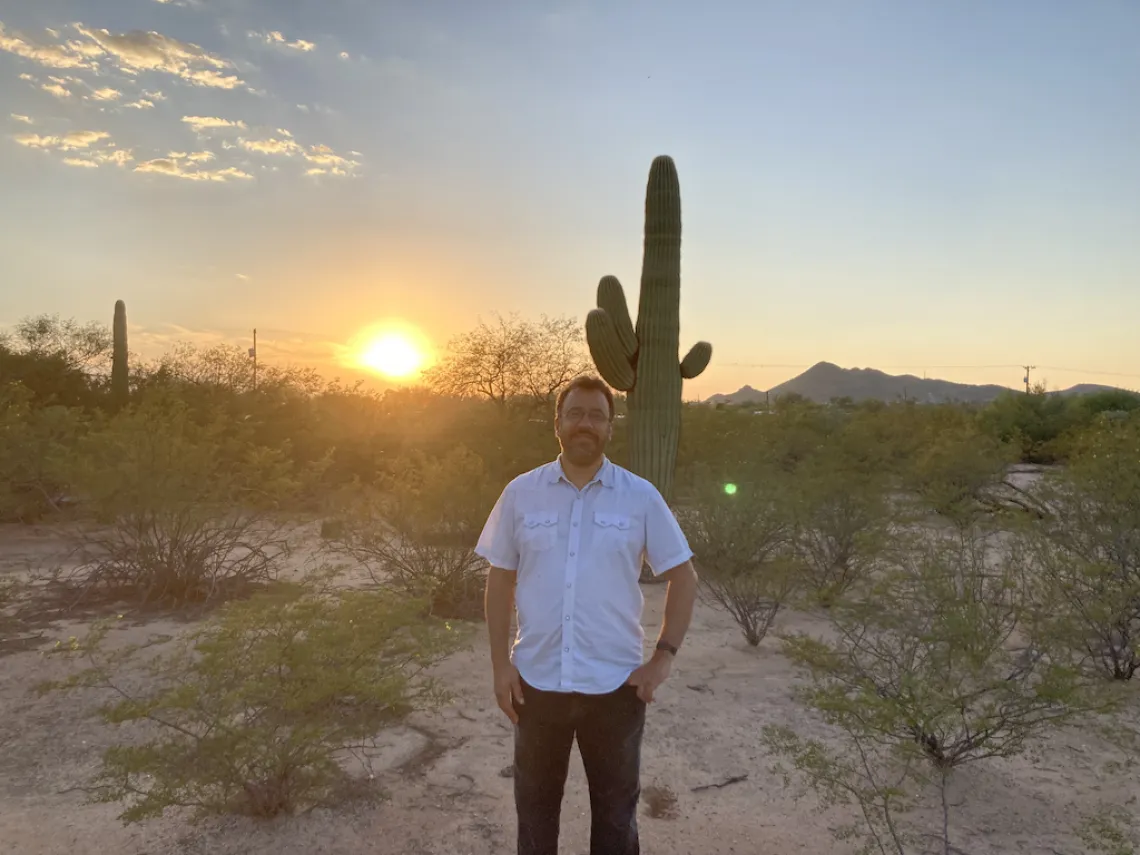Q&A with Estevan Azcona: Evolution and Impact of Son Jarocho and Movimiento Music

Estevan Azcona
The first full weekend of October, the 15th Fandango Fronterizo took place at Friendship Park — the U.S.-Mexico security zone at the border fence between San Diego and Tijuana. Originating in 2007, this musical event is organized by the local son jarocho music community and brings together musicians, dancers and community members from both sides of the border to participate in a celebration of music and dance, a statement against the divisions and challenges faced by border communities.
Son jarocho is a traditional form of music from Veracruz, Mexico, and blends Mexican, Spanish and African elements. Rooted in themes of nature, daily life and social issues, the music has a strong tradition of community participation with a focus on gatherings called “fandangos” where people get together to promote a sense of community and cultural identity through the music. Not broadly popular in the U.S., son jarocho has garnered recognition and “gained popularity by bands like Quetzal and Ozomatli, who embraced the music and gave it a platform some 20 years ago,” said Estevan Azcona, assistant research social scientist in the Southwest Center and assistant professor of Mexican American Studies.
Azcona researches Latin American ethnomusicology, and borderlands anthropology and history. He is a co-producer of the Smithsonian Folkways Recordings release, Rolas de Aztlán: Songs of the Chicano Movement, an album that features movimiento music, or movement music, which highlights recordings that came out of the Chicano movement. Recently, Azcona talked about how son jarocho and movimiento music have evolved, highlighting their commonalities and distinctions.
Why did you focus your career and research on Latin American ethnomusicology?
I see research on Chicana/o/x music culture as a part of larger historical processes and experiences not just in Mexico, but also in Latin America. [These] music cultures are certainly also American music cultures, but they are deeply connected to histories and aesthetics in the hemisphere. My own research on movimiento music has shown there are direct connections to protest song traditions throughout Latin America, and that contemporary Chicana/o/x popular music-making and fandoms are also connected to trends in this part of the world.
Your research is deeply focused on movimiento music. What is it about?
Movimiento musicians were activists or closely related to those circles during the Chicano Movement. They played at public rallies and meetings of the movement, and they sang about everything from identity to race, to specific kinds of campaigns, such as the farmworkers and what they were doing, to solidarity with current or historic struggles for justice. The songs ranged from broad movement themes to very local issues, for example, a farm worker song might be about a specific grower, the owner of the farm, and the way the workers were treated.
What are the hallmarks of son jarocho music?
It is a very participatory tradition, and you go not to sit and watch but to play music, sing, and dance. Son jarocho is about honoring community ties and coming together by sharing these expressive traditions. It’s typically very local and comprised of people from small pueblos and ranch towns, where you can count on your hands everyone who lives in the area but can be organized around a larger sense of community, the Fandango Fronterizo is an example of such a gathering.
The Fandango Fronterizo brings participants together from both sides of the border for a celebration of music and dance. The event symbolizes unity and solidarity, emphasizing cultural ties and transcending political boundaries. How has it changed over time?
It has evolved and changed with its content and size but still has its roots in “remaking” the community. Also, there is an implicit critique of border and immigration issues. That may be loosely based on the problems that son jarocho musicians from Veracruz face in their attempts to cross the border to share music culture with ethnic Mexican communities in the U.S., but it seems to speak more to communities on both sides about the problem of the border wall and contemporary immigration policies. Son jarocho has been very present in the world of Chicana/o/x music — from Los Lobos, who have their own incredible story with son jarocho, to more contemporary groups — like Cambalache and Las Cafeteras — who have taken the sound to a new level of popularity.
Do son jarocho and movimiento music inform popular Chicana/o/x music?
Son jarocho is a part of Caribbean music culture as Veracruz state sits on the Gulf of Mexico, and there are definite links to other Afro-Caribbean musics, but it is more present among Chicanos than Latinos in general. Movimiento music is more of a historical influence than a musical influence on our contemporary sounds insofar as it stands as a sound defined by a significant historical moment, shaped by contemporary politics, identities, and how the struggle for social change continues today.
What do you wish more people understood when it comes to music history?
I would say [understanding] how connected movimiento was to numerous social movements and the music of those movements. There are direct connections to nueva canción from Latin America to the music of the Cuban Revolution, and Mexican versions of the above — as well as the regional traditional music from Mexico. But it was also directly connected to labor and union songs, to Freedom Songs of the Southern Civil Rights Movement, and American popular music from the folk revival to Santana.

